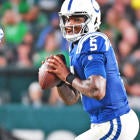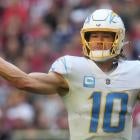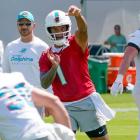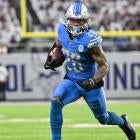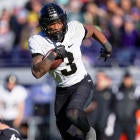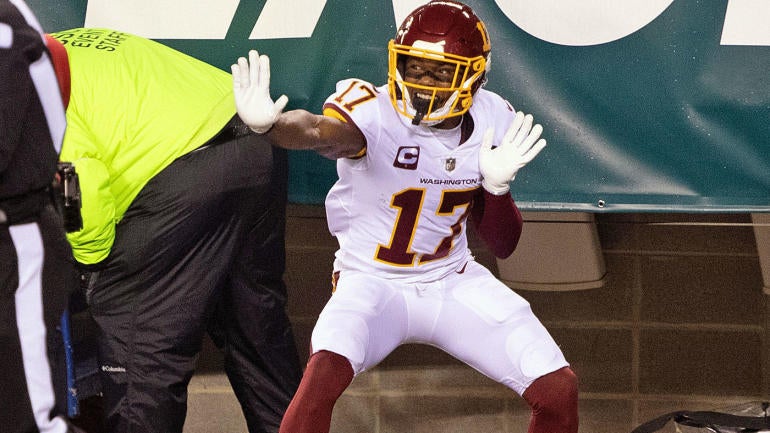
Over the past three seasons, no one has dominated targets (and Fantasy Football) quite like Davante Adams. His 10.9 targets per game lead all players since 2018 and his 21.4 PPR Fantasy points per game is a full 1.4 points per game better than any other wide receiver. That's why, for as long as Aaron Rodgers remains in Green Bay, Adams is the consensus No. 1 receiver in PPR leagues and a cinch as a first-round pick.
But it wasn't always like this for Adams. In his first two years in the NFL, he was below six targets per game. The next two years, he made a small improvement to 7.9, but it wasn't until Year 5 that Adams started seeing double-digit targets per game. Other star receivers took similar, if more hastened, paths.
- Michael Thomas averaged eight targets per game as a rookie, 9.3 in his second and third year combined, then saw a target explosion to 11.6 per game in Year 4.
- DeAndre Hopkins averaged 5.7 as a rookie, jumped to 7.9 in his second season, and has been at or near 10 targets per game every year since.
- Tyreek Hill was around five per game as a rookie and saw that jump to seven in Year 2, before hitting 8.6 in his third season.
You get the idea. And while Hill has never quite got to the level of Adams, Thomas, or Hopkins in terms of targets, his elite efficiency makes him one of the best receivers in football anyway. And that may be the path forward for the next elite Fantasy receivers. As NFL offenses continue to become more and more diversified, double-digit targets per game should become more and more rare. That doesn't mean there won't be future target hogs, it's just that they won't be able to dominate without efficiency that looks more like Hill's than Adams, Hopkins, and Thomas.
With that in mind, there are a handful of guys well on their way. Here are eight potential target hogs, and several of them could take a big leap this season:
A.J. Brown, Titans
2019 T/G: 5.3
2020 T/G: 7.6
Brown's potential target breakout will be impacted by the changes around him. Corey Davis, Adam Humphries, and Jonnu Smith were let go, replaced by Julio Jones, Josh Reynolds, Dez Fitzpatrick, and Anthony Firkser. But I'd submit that Brown's breakout is inevitable no matter who was on this roster.
If you're looking for a Tyreek Hill archetype when it comes to production, this is your man. Brown's target numbers obviously match up well, and his efficiency has actually been better. There's very little chance Brown is maintaining his 11.2 yards per target and 10% touchdown rate once he elevates to 130-plus targets, but Hill's 9.8 YPT and 8.6% touchdown rate show that elite efficiency is possible even with a volume increase.
If you're looking for the receiver who could leap from outside the top 12 to top three at receiver this year, it's Brown, even with Jones on the roster. His skillset, his youth, and his lack of competition for targets make him the top breakout candidate at wide receiver, worthy of a pick as early as Round 2.
Terry McLaurin, Washington
2019 T/G: 6.6
2020 T/G: 8.9
If Brown is the Hill archetype, McLaurin could be one of the few young receivers who actually has a shot of following the Michael Thomas or DeAndre Hopkins path. But McLaurin will have to fight through even more competition. Curtis Samuel and Dyami Brown could both cut into McLaurin's share of the wide receiver targets, but Ryan Fitzpatrick should make sure that wide receiver pie grows.
Last year McLaurin earned nearly nine targets per game on a team that threw only 51.6% of its pass to receivers. That was the third lowest mark in the league, and it was heavily impacted by Alex Smith. Fitzpatrick is a completely different type of quarterback who should give McLaurin more downfield looks. Remember what he did for the Tampa Bay receivers in 2018, or DeVante Parker in 2019?
The only word of caution is that McLaurin's 2020 looks a lot like D.J. Moore's 2019. If you'll remember, they even had the same coaches. Moore got new coaches in 2020, and more competition for targets, and he actually saw his targets fall in his third season. While McLaurin's coaching staff didn't change, we'll have to be wary of the Washington Football Team becoming more multiple until we see them in 2021.
As of now, view McLaurin as a potential target hog worth a pick at the end of Round 2 or early in Round 3 in a PPR league.
DK Metcalf, Seahawks
2019 T/G: 6.3
2020 T/G: 8.1
Metcalf was one of the biggest breakouts at wide receiver in 2020 and it's fair to wonder if there is still room for growth. Looking at his game logs, it becomes obvious there is.
Whether you want to ascribe it to game script or matchup, Metcalf disappeared far too often in 2020. He had five games with fewer than 50 yards and he didn't top 61 receiving yards in his final four regular season games.
A lot of this seems to revolve around the NFC West. Metcalf was held below 60 yards in five of six games within the division last year. What's more, he has six catches for 75 yards in four career games against Patrick Peterson and the Cardinals. Maybe Peterson leaving for Minnesota will be enough to improve Metcalf's consistency.
While Peterson definitely had something to do with this, it seems more accurate to say that teams have found a way to take Metcalf away at times. It's also accurate to say that the Seahawks have done that to themselves at times with their offensive game plan. And we don't know for certain what they'll do in 2021 Shane Waldron taking over.
All that being said, elite receiver prospects who produce 2,200 yards before their 24th birthday don't generally see less volume moving forward. And while Tyler Lockett is still in his prime, he won't be for much longer. Even if Metcalf doesn't make the leap to target hog in 2021, it seems inevitable in the next couple of years. That's why he's a top-five Dynasty receiver. And he's worth a third round pick in redraft leagues, just in case this is the year he makes another leap.
Diontae Johnson, Steelers
2019 T/G: 5.8
2020 T/G: 9.6
In many ways, Johnson could make the claim that he's already one of the top target funnels in the league. Including the playoffs, Johnson played 13 full games with Ben Roethlisberger. In those 13 games he averaged 11.8 targets per game. He saw double-digit targets in all but two of those games.
So what's the catch?
No pun intended, but part of it is Johnson's 61.1% catch rate. He struggled with drops in his second year and the Steelers have no shortage of weapons to throw to with JuJu Smith-Schuster, Chase Claypool, Eric Ebron, and James Washington. All three of those receivers averaged more yards per target than Johnson last year.
Also, there's the question of just how often Pittsburgh wants to throw after drafting Najee Harris in the first round. They've been amongst the league leaders in pass attempts when Roethlisberger has been healthy over the past three years, is that about to change? We're not betting on it.
The upside, if Johnson stays healthy, stops dropping easy catches, and the Steelers keep throwing? He could absolutely lead the NFL in targets, catches, and maybe even PPR Fantasy points. If he somehow matched the pace he was on in those 13 games for a full 17-game season he'd had 124 catches and 1,237 yards on 200 targets.
That's incredible upside, just know his floor may be the lowest of anyone mentioned in this article, and for that reason he's best drafted as a No. 2 receiver in Round 4 in PPR (and significantly later if catches don't count).
Justin Jefferson, Vikings
2020 T/G: 7.8
You couldn't do this piece without at least mentioning one of the best rookie receiver seasons of all time. As impressive as Jefferson's 88-1,400-7 on 125 targets was, it doesn't even tell the whole story. He had six targets combined in his first two NFL games. After that he averaged 8.5 targets and 95 receiving yards per game.
As with Brown, we know there's some regression coming for Jefferson off of his 11.2 yards per target, but Hill again serves as an example of a player who has been able to stay near 10 yards per target at near nine targets per game. Considering Jefferson's youth and the fact that Adam Thielen turns 31 before the season starts, the expectation should be that Jefferson's target share will go up.
Mike Zimmer is notorious for his preference to run the ball and play good defense, but even he has to see how special Jefferson's rookie year was. And it's unlikely the Vikings will go from last year's defensive debacle that Zimmer called his "worst ever" to something more than a slightly above average defense.
Jefferson is already a top-five Dynasty wide receiver and it shouldn't surprise anyone if he's a top-five redraft receiver in 2021. He should be drafted as early as Round 2 in full PPR leagues.
Ja'Marr Chase, Bengals
This is unfair, I'll admit it. But Jefferson's teammate on the 2019 LSU Tigers was reunited with their quarterback on that same team, Joe Burrow. And while it's not normal for a rookie to jump into the target hog discussion as a rookie, it's also not unprecedented.
Eight rookie receivers have topped 130 targets in their rookie year, most recently Amari Cooper in 2015 and Odell Beckham in 2014 (in 12 games!). Jefferson was easily on that pace after his first two games, and he didn't have the advantages Chase enjoys.
Chase joins a Bengals team that was averaging 40 pass attempts per game last year before Joe Burrow's injury. A.J. Green saw 105 targets on that team, despite catching just 45% of his targets. Between the departure of Green and lower end targets, the Bengals actually have 149 wide receiver targets to replace from 2020.
So while it may look like a crowded situation with Tee Higgins and Tyler Boyd already established, just remember that Chase has played more football with Burrow than Higgins or Boyd. And while we're at it, it might be worth remembering how good that duo was.
In 2019 at LSU, Chase caught 84 passes for 1,780 yards and 20 touchdowns. Not only was he more productive than Jefferson, but he led the nation in receiving yards, receiving touchdowns, and yards per reception on his way to winning the Fred Biletnikoff Award as the best receiver in college football.
Even with that profile, being a rookie in the NFL comes with its share of risk, so Chase is best drafted as a No. 2 receiver in Round 5. Just don't sell short his upside, which over the next two or three years is as high as any receiver in football.
Jerry Jeudy, Broncos
2020 T/G: 7.1
It might seem weird to think that Jeudy's targets could go up with Courtland Sutton coming back. But it would also seem kind of weird if the 15th overall pick earned 113 targets as a rookie and then saw his role decrease.
Jeudy's catch rate (47.6%) was miserable last year but only about 60% of his targets were even catchable. Considering Jeudy didn't have a serious hands issue in college, we can chalk last year's problems up to a combination of Drew Lock and rookie struggles. While it's true that Lock could still be the starter, they now have Teddy Bridgewater in case Lock doesn't take a step forward. And, of course, there's still some hope they'll have Aaron Rodgers.
If you prefer Sutton in Dever, that's fine, he's going much earlier. I wouldn't hate the idea of taking Sutton in Round 6 or Round 7 and then Jeudy a couple of rounds later. But Jeudy's route running ability makes him a much more likely candidate to eventually reach target monster status even if it doesn't fully happen until after 2021.
Brandin Cooks, Texans
2018 T/G: 7.3
2019 T/G: 5.1
2020 T/G: 7.9
Outside of his weird 2019 season, Cooks has consistently been between seven and eight targets per game every year since 2015. That consistency, combined with the fact that he'll turn 28 years old might seem to make him an odd fit for this column. At least until you look at the Texans' depth chart.
There are a lot of names on the list but Randall Cobb is the only other receiver who has ever earned 100 targets in a season, and he hasn't reached that number since 2015. With Will Fuller gone, the cupboard is bare behind Cooks, and we saw a glimpse of what that could mean at the end of 2020.
In four games without Fuller, Cooks averaged 10.3 targets and 107.8 receiving yards per game. The Texans simply haven't added enough to this receiving corps to expect anything other than Cooks getting peppered with targets.
Targets from who? We don't know, unfortunately.
What we do know is that behind Deshaun Watson the Texans now have veteran Tyrod Taylor and rookie Davis Mills. While that's a massive dropoff, one or both of those guys would seem capable of force-feeding Cooks. And if that's the case this team is going to be so bad that every second half may be garbage time.
Until we know Watson's status, guessing Cooks' ADP is a fool's errand. He could be drafted anywhere from Round 6 to Round 10. If Watson is the Week 1 starter, we'd expect Cooks to be worth a Round 4 or Round 5 pick. If it's Taylor or Mills, Cooks could still justify a pick in Round 7. In other words, the risk is being baked into his cost. What's not baked in is the real possibility Cooks turns into a target monster.
















